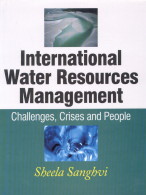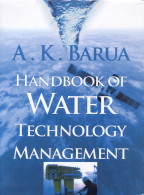

| 
Agricultural
Water Management in Humid Tropics/K.M. Varadan. Jodhpur, Agrobios (India),
2002, 184 p., tables, figs., $39.ISBN 81-7754-151-X. Want
To Buy This Book?
| Contents:
I. Introduction: 1. Sub-humid climatic feature of Kerala. II. Location,
physiography and landuses: 1. Location. 2. Physiography. 3. Land use. 4. Agriculture.
III. Basic principles in water management: 1. Water in soil. 2. Water in
plants. 3. Soil-plant-atmosphere continuum. 4. Consumptive use or water requirement.
5. Measurement of evaporanspiration. IV. Biophysical resources: 1. Land
form. 2. Soil types. 3. Soils under different land forms. 4. Climate. V. Hydrologic
characteristics and water management: 1. Effective Rainfall (ER). 2. Rainfall—runoff
relations under different land uses. 3. Soil water properties. 4. Soil moisture
depletion. 5. Ground water fluctuation. 6. Hydrologic processes. VI. Water
management of crops: 1. Rice. 2. Upland crops. 3. Crop water deficit. VII.
Watershed management: 1. Concept. 2. Planning. 3. Development. 4. Evaluation.
VIII. Irrigation management: 1. General. 2. Irrigation projects. 3. Irrigation
methods. IX. Socio-economic aspects of water management: 1. Irrigation
projects. 2. Watershed development. X. Water management and environment:
1. Soil erosion and sedimentation. 2. Ground water recharge. 3. Water logging.
4. Disease control. XI. Water management information: 1. Scope. 2. Information
needs. 3. DSS and expert systems. References. Appendices. Subject index. | 
International
Water Resources Management : Challenges, Crises and People/Sheela Sanghvi. New
Delhi, Dominant Pub., 2007, vi, 308 p., $60. ISBN 81-7888-476-3. Want
To Buy This Book?
| Contents:
I. Introduction: 1. Sub-humid climatic feature of Kerala. II. Location,
physiography and landuses: 1. Location. 2. Physiography. 3. Land use. 4. Agriculture.
III. Basic principles in water management: 1. Water in soil. 2. Water in
plants. 3. Soil-plant-atmosphere continuum. 4. Consumptive use or water requirement.
5. Measurement of evaporanspiration. IV. Biophysical resources: 1. Land
form. 2. Soil types. 3. Soils under different land forms. 4. Climate. V. Hydrologic
characteristics and water management: 1. Effective Rainfall (ER). 2. Rainfall—runoff
relations under different land uses. 3. Soil water properties. 4. Soil moisture
depletion. 5. Ground water fluctuation. 6. Hydrologic processes. VI. Water
management of crops: 1. Rice. 2. Upland crops. 3. Crop water deficit. VII.
Watershed management: 1. Concept. 2. Planning. 3. Development. 4. Evaluation.
VIII. Irrigation management: 1. General. 2. Irrigation projects. 3. Irrigation
methods. IX. Socio-economic aspects of water management: 1. Irrigation
projects. 2. Watershed development. X. Water management and environment:
1. Soil erosion and sedimentation. 2. Ground water recharge. 3. Water logging.
4. Disease control. XI. Water management information: 1. Scope. 2. Information
needs. 3. DSS and expert systems. References. Appendices. Subject index. | 
Handbook of
Water Technology Management/A.K. Barua. New Delhi, Dominant Pub., 2007, viii,
346 p., figs., tables, $55.ISBN 81-7888-478-X.
Want
To Buy This Book?
| Contents:
Preface. I: 1. Water and its management. 2. Water conservation for sustainable
future. 3. Drought prone areas: development and management strategies. 4. Dynamics
of water ecology. 5. Toxicity of environmental chemicals. 6. Case studies in water
management and utilisation. 7. Environmental pollution: causes and consequences.
II: 1. Sustainability of water use. 2. Water resource development and environmental
planning. 3. Evolution of irrigated farming. 4. Water management planning in Arid
regions. 5. Ground water project for land fill site: a case study from Africa.
6. Rain water harvesting. 7. Profile of fresh water springs. 8. Harnessing hydro-power
potential. 9. managing water resource in mega cities cited and supplementary references.
"The
present publication focuses on major issues related to the water sector. A large
number of publications has been brought out related to various aspects of this
natural resource but the present handbook extend the discussion from the conventional
approach such as mobilisation, provision and consumption to all related issues
and profile a comprehensive picture of this vital resource. The publication covers:
water and its management; water conservation for sustainable future; drought prone
areas; dynamics of water ecology; toxicity of environmental chemical; case studies
in water management and utilisation; environmental pollution; sustainability of
water use; water resource development and environmental planning; evolution of
irrigated farming; water management a planning in Arid regions; ground water project
for land fill site; Rain water harvesting; profile of fresh water springs; harnessing
hydro- power potential and managing water resource in mega cities." (jacket)
. |
|
|